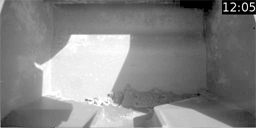Emily Lakdawalla • Jul 16, 2008
A quick update on Phoenix, sol 50: Got ice? Yes!
Phoenix has successfully used its rasp tool to enable the acquisition of a sample of ice-rich soil from the surface of Mars. That's the highlight of this week's Phoenix update. I got in touch with Ray Arvidson (usually referred to as the "digging czar" when he's on a press panel, though I highly doubt he'd introduce himself that way) while both of us were traveling; in fact it seems Ray was standing in the visitor's center of Meteor Crater, Arizona when I reached him. (For my part, I'd managed to send the baby off with her uncle to the playground to get a few minutes of peace.)
Conditions were not ideal for this update so it'll be less thorough than most, but I figure it's better than nothing. Highlights this week:
- Ray was elated about just how well the rasp had worked on their first try. Last week Mark Lemmon "virtually guaranteed" me there would be false starts with the rasp -- but it seems I should ask him for my money back.
- The first rasp attempt involved two raspings, which created two little holes in the flat surface at the bottom of the Snow White trench, "like a snake bite," Ray said.
- Then they successfully tipped the sample through the back of the bucket into the front where they could watch it over the course of several hours. As they hoped, some of the sample disappeared, indicating it was ice.
- The next step is to run through the procedure to acquire a sample of the right size for TEGA, and make sure they can rasp, get it into the front of the scoop, and get it ready for delivery all in one sol. This sample will involve a four-by-three array of little rasp holes.
- Then, with that test sample successful, they will get ready for the real thing: scrape to fresh ice, after which they'll get a four-by-four array of raspings.
- They'll open the doors on TEGA oven 0 probably two sols before this sample attempt. The actual sample attempt will unfold over an activity cycle requiring two sols, because they want to get the sample into TEGA before 7 am local solar time, keeping the temperature as low as possible, to prevent sublimation before it gets in to TEGA. To do that, they need to do "a lot of heating" on the robotic arm to make it ready for all the activity it has to do in the wee hours of the morning.
- How did Ray feel about the success of the first rasping? "It was really sweet."
- So we're probably looking at next week for the first TEGA sample. This seems like a constantly moving target, but it's got to be close now...
- In other news, the Atomic Force Microscope is completely checked out. They've done a test run on a sample they brought from Earth. Now they are doing "dynamic tests to make sure they approach soil particles gently" with the needle tip of the microscope. Ray said it should be less than a week until the first scan of a sample acquired on mars.

NASA / JPL / UA / animation by Daniel Crotty
Watching rasp scrapings sublimate on sol 50
On sol 50, Phoenix used its rasp tool to scrape fine shavings from the Martian surface into its robotic arm scoop, then took five images of the contents over the course of eight hours to watch for changes. The changes are subtle, but some of the scrapings did sublimate over the course of the day, indicating that Phoenix successfully acquired a sample of ice-rich soil.I apologize for this update being short, but so's my time. Next week's will be better!
Support our core enterprises
Your support powers our mission to explore worlds, find life, and defend Earth. You make all the difference when you make a gift. Give today!
Donate

 Explore Worlds
Explore Worlds Find Life
Find Life Defend Earth
Defend Earth

